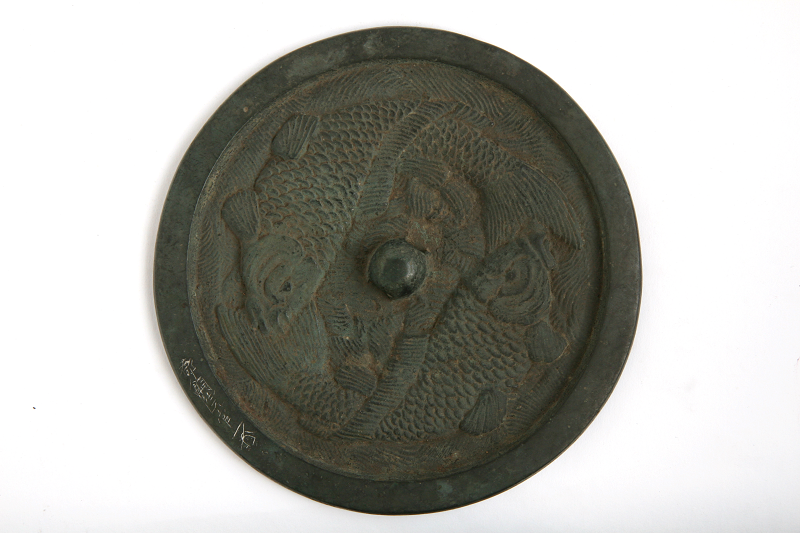Bronze Mirror with Double Goldfish Design

Jin Dynasty (1115–1234)
Diameter: 18.7cm
It is a round-shaped mirror with a round knot in the center. The back of the mirror is decorated with double goldfish design. The two carps frolicking around the knot in an anticlockwise direction. The mirror demonstrates exquisite craftsmanship. The scales and fins of the two carps are clearly and lively represented. Realistic approach and high relief technique are employed to represent the vividness of these two carps as if they are two live fish swimming in the pool.
The margin of the mirror is inscribed “都铜院官(☆)”(Du Tong Yuan Guan) and there is a mark. Inscription at the margin of the back of the mirror is the most important feature of the bronze mirrors produced during Jin Dynasty. It is also of great significance for the study of the specific year during which the mirror was manufactured. “都铜院官(☆)”(Du Tong Yuan Guan) refers to the fact that the mirror was made by government-owned factories. During Jin Dynasty, the production of bronze was strictly controlled. Generally speaking, most of the bronze mirrors were produced by the government-owned factories and the margin of the back of mirrors was inscribed with the place of the factory and the name of the administration which governed the factory. What’s more, the bronze mirrors produced before Jin Dynasty and owned by the common, also had to be examined and inscribed with detailed information. The most inclusive inscription includes the following information: time, the administration which examined the mirror, the administration which produced the mirror, the weight of the mirror and the mark.
The mark, also called “signature”, originated from Song Dynasty and became popular in Yuan Dynasty. Therefore it is sometimes named as “Yuan Mark”. The mark is often oblong shaped, inscribed with names in the regular script and Phags-pa script. Since the mark was difficult to copy and imitate, it could serve as the anti-counterfeit trademark. Such a practice was maintained until Ming and Qing Dynasties.
深入探索
Bronze mirrors in Jin Dynasty
Bronze mirrors in ancient China boast of the unique features of the Chinese traditional craftsmanship. Their casting, shapes, the designs on the back, and inscriptions are all closely related to the periods during which they were produced. Jin Dynasty (1115–1234) was founded by the Wanyan clan of the Jurchens in the Northeast of China. They made substantial political and economic progress. By integrating the traditional techniques of the Han Chinese in the Central Plain of China and the rough and straightforward characteristics of this nomadic people, the Jin people had achieved their uniqueness in terms of the production of bronze mirrors.
The design at the back of bronze mirrors of Jin Dynasty was based on the popular folklores or legends, or the design favored by the common people. Its innovative and representative design is the double fish mirror. The design became increasingly popular during the prosperous Jin Dynasty. Therefore, modern bronze mirror collectors named the double fish bronze mirror as “Gold•Double Fish Bronze Mirror”. This was closely linked to the facts that early Jurchens ancestors lived by fishing and hunting and they were influenced by the culture of the Central Plain.
In traditional Chinese culture, fish has always been favored by the people. From the ancient painted pottery of Yangshao Culture of the Neolithic period to the Red-colored Plate with blue flower glaze of the late Qing Dynasty and Republic of China, the design of fish serves as a popular ornamentation. For the past several thousand years, China had been an agrarian economy. Favorable weather was needed so as to ensure the bountiful harvests. Fish was the most common animal in the water and it was worshipped as the god of water by people. Fish was also regarded as the symbol of auspiciousness. This was written in several historical records, for example, The Imperial Readings of the Taiping Era (Chinese: 《太平御览》; pinyin: Tai Ping Yu Lan), which is a massive encyclopedia compiled by a number of officers commissioned by the imperial court of the Song Dynasty.



